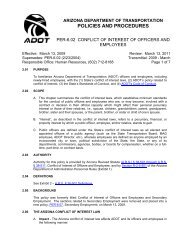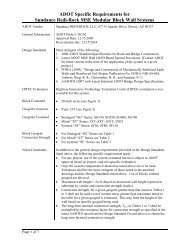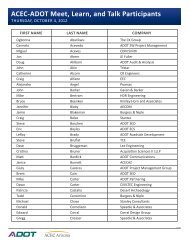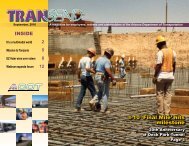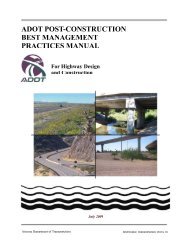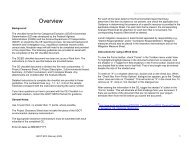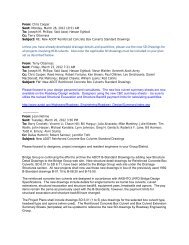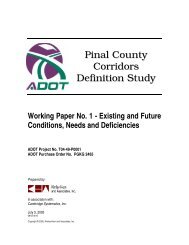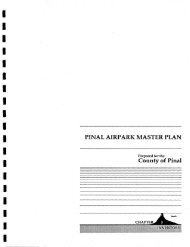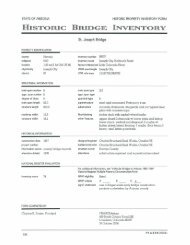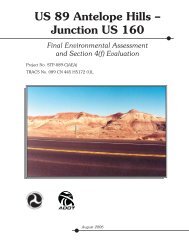I-10 Twin Peaks Traffic Interchange, Environmental Assessment
I-10 Twin Peaks Traffic Interchange, Environmental Assessment
I-10 Twin Peaks Traffic Interchange, Environmental Assessment
You also want an ePaper? Increase the reach of your titles
YUMPU automatically turns print PDFs into web optimized ePapers that Google loves.
Affected Environment and <strong>Environmental</strong> Impacts October 2005<br />
conducted to determine the types of species and number of individual plants that<br />
would be impacted.<br />
Mitigation<br />
To protect vegetation resources in the project area, a revegetation plan would be<br />
developed prior to construction activities. The Town of Marana would develop a<br />
Native Plant Protection Plan (NPPP) in accordance with local ordinances.<br />
Protected native plants within the construction limits would be impacted by the<br />
preferred alternative; therefore, the ADOT Roadside Development Section would<br />
notify the Arizona Department of Agriculture (ADOA) at least 60 days prior to the<br />
start of construction to afford commercial salvagers the opportunity to remove and<br />
salvage these plants.<br />
Conclusion<br />
One Salvage Restricted plant species listed under the ANPL, the Tumamoc<br />
globeberry, has been documented by AGFD as occurring within 2 miles of the<br />
study area. Tumamoc globeberry were not observed during a pedestrian survey of<br />
the study area and existing land use has disturbed suitable habitat for the Tumamoc<br />
globeberry. In addition, native plants protected by the ANPL, Marana NPPO and<br />
Pima County NPPO are present within the project area and would be impacted by<br />
construction of the preferred alternative. A revegetation plan would be developed<br />
prior to construction activities and a NPPP would be developed by the Town of<br />
Marana to address impacts to native vegetation and develop mitigation measures.<br />
Vegetation, Riparian Habitat, and Wetlands<br />
Existing Conditions<br />
Vegetation in the study area is a mosaic of natural upland vegetation, small dry<br />
ephemeral washes, disturbed and re-established riparian areas, wetland vegetation<br />
of the Santa Cruz River, and disturbed and landscaped vegetation associated with<br />
residential housing, commercial businesses, and light industry. Most of the natural<br />
vegetation in the study area occurs: 1) within the high flow channel of the Santa<br />
Cruz River; and, 2) along Linda Vista Boulevard, particularly between El Camino<br />
de Mañana (west) and Hartman Lane (east).<br />
Natural vegetation in the study area is representative of three vegetation<br />
communities: 1) Arizona Uplands; 2) Riparian Scrub; and, 3) Cottonwood/Willow<br />
Riparian Forest. Arizona Uplands vegetation exists in the upland areas along Linda<br />
Vista Boulevard and is characterized by foothills palo verde, saguaro, velvet<br />
mesquite, triangle-leaf bursage, and cholla cactus. The most intact Arizona<br />
Uplands Vegetation occurs along Linda Vista Boulevard west of Hartman Lane.<br />
Arizona Uplands vegetation along Linda Vista Boulevard east of Hartman Lane<br />
has been fragmented as a result of residential development. No natural landscapes<br />
of Arizona Upland vegetation remain on the west side of the study area because of<br />
the Continental Ranch housing development. Small and scattered remnant Sonoran<br />
Interstate <strong>10</strong> <strong>Traffic</strong> <strong>Interchange</strong> at<br />
<strong>Twin</strong> <strong>Peaks</strong>/Linda Vista<br />
4-36<br />
Project No.: NH-0<strong>10</strong>-D (AIW)<br />
TRACS No.: <strong>10</strong> PM 236 H5838 01D



